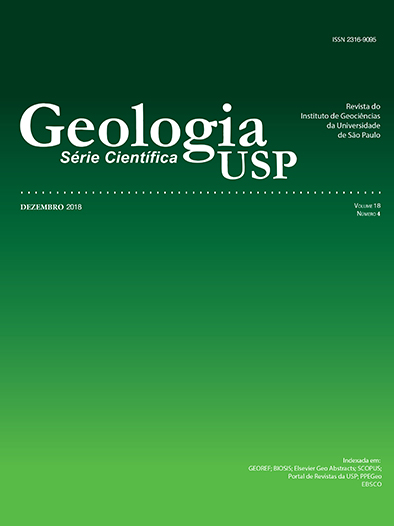Chemical characterization of mineralized holocene plant from Camocim, Ceará, Brazil
DOI:
https://doi.org/10.11606/issn.2316-9095.v18-142477Keywords:
Eolianites, Coastal zone, Plants, Ceará, HoloceneAbstract
This research focused on analyzing and identifying the chemical composition of plants remains mineralized by burial, present in eolianites, from the Camocim coastal zone, in order to find qualitative and quantitative ways of preserving these materials’ mineral identity. The analyses were made by Energy Dispersive X ray Spectrometer technique in electronic microscope, a qualitative and semi-quantitative method used for materials elemental identification. We also prepared five samples following the Physics degree’s Central Analytica utilization norms of Universidade Federal do Ceará, where analyses were made; the samples were fragmented to the limit of 1 cm, following sputter coating by gold, later observed in scanning electronic microscope Inspect S50 FEI, that has an Energy Dispersive X ray Spectrometer. Results revealed that these five samples didn’t present significant variations between their chemicals compositions, being primarily made of calcium carbonate (CaCO3), which represent more than 90% of the composition in each one, deriving from plentiful marine bioclasts in sedimentary contents of Camocim coastal zone. Trace elements like magnesium, silicon, aluminum, iron and chlorine were present as well, and their presence may be related to diverse diagenetic compositional origin of deposited sediments at the coastland.
Downloads
Downloads
Published
Issue
Section
License
Authors who publish in this journal shall comply with the following terms:
- Authors keep their copyright and grant to Geologia USP: Série Científica the right of first publication, with the paper under the Creative Commons BY-NC-SA license (summary of the license: https://creativecommons.org/licenses/by-nc-sa/4.0 | full text of the license: https://creativecommons.org/licenses/by-nc-sa/4.0/legalcode) that allows the non-commercial sharing of the paper and granting the proper copyrights of the first publication in this journal.
- Authors are authorized to take additional contracts separately, for non-exclusive distribution of the version of the paper published in this journal (publish in institutional repository or as a book chapter), granting the proper copyrights of first publication in this journal.
- Authors are allowed and encouraged to publish and distribute their paper online (in institutional repositories or their personal page) at any point before or during the editorial process, since this can generate productive changes as well as increase the impact and citation of the published paper (See The effect of Open Access and downloads on citation impact).





